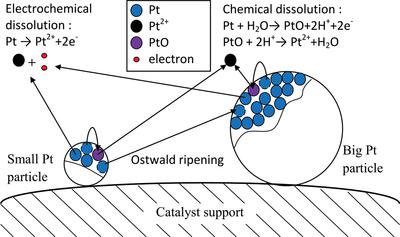当前位置:
X-MOL 学术
›
Fuel Cells
›
论文详情
Our official English website, www.x-mol.net, welcomes your feedback! (Note: you will need to create a separate account there.)
Proton exchange membrane fuel cell degradation model based on catalyst transformation theory
Fuel Cells ( IF 2.8 ) Pub Date : 2021-03-29 , DOI: 10.1002/fuce.202100002 Yunjin Ao 1 , Kui Chen 1 , Salah Laghrouche 1 , Daniel Depernet 1
Fuel Cells ( IF 2.8 ) Pub Date : 2021-03-29 , DOI: 10.1002/fuce.202100002 Yunjin Ao 1 , Kui Chen 1 , Salah Laghrouche 1 , Daniel Depernet 1
Affiliation

|
Durability is a severe problem in the commercial application of proton exchange membrane fuel cell (PEMFC). The platinum (Pt) catalyst which greatly affects performance and durability is one of the most important components in PEMFC. However, few PEMFC degradation models focused on the Pt catalyst degradation process in molecule scale. In this paper, a novel PEMFC catalyst degradation model is developed based on the catalyst transformation theory. In this model, the Pt catalyst degrades by changing form and size according to the transformation theory, which includes Pt dissolution and Ostwald ripening mechanisms. The advantage of this new model is that the transformation of every Pt particle is calculated directly, and the characteristics of every particle are considered, thus it can give more accurate catalyst degradation process. Six groups of experimental data have been used to validate the effectiveness of the proposed degradation model of PEMFC. Furthermore, the accuracy of the proposed degradation model is superior to a traditional model, and the application of such a degradation model to the performance prediction of the PEMFC has been discussed.
中文翻译:

基于催化剂转化理论的质子交换膜燃料电池降解模型
耐久性是质子交换膜燃料电池(PEMFC)商业应用中的一个严重问题。铂 (Pt) 催化剂对性能和耐久性有很大影响,是 PEMFC 中最重要的组成部分之一。然而,很少有 PEMFC 降解模型专注于分子尺度的 Pt 催化剂降解过程。在本文中,基于催化剂转化理论开发了一种新的 PEMFC 催化剂降解模型。在该模型中,Pt 催化剂根据转化理论通过改变形状和尺寸而降解,包括 Pt 溶解和 Ostwald 成熟机制。这种新模型的优点是直接计算每个Pt粒子的转化,并考虑了每个粒子的特性,从而可以给出更准确的催化剂降解过程。六组实验数据已用于验证所提出的 PEMFC 降解模型的有效性。此外,所提出的退化模型的准确性优于传统模型,并且讨论了这种退化模型在 PEMFC 性能预测中的应用。
更新日期:2021-03-29
中文翻译:

基于催化剂转化理论的质子交换膜燃料电池降解模型
耐久性是质子交换膜燃料电池(PEMFC)商业应用中的一个严重问题。铂 (Pt) 催化剂对性能和耐久性有很大影响,是 PEMFC 中最重要的组成部分之一。然而,很少有 PEMFC 降解模型专注于分子尺度的 Pt 催化剂降解过程。在本文中,基于催化剂转化理论开发了一种新的 PEMFC 催化剂降解模型。在该模型中,Pt 催化剂根据转化理论通过改变形状和尺寸而降解,包括 Pt 溶解和 Ostwald 成熟机制。这种新模型的优点是直接计算每个Pt粒子的转化,并考虑了每个粒子的特性,从而可以给出更准确的催化剂降解过程。六组实验数据已用于验证所提出的 PEMFC 降解模型的有效性。此外,所提出的退化模型的准确性优于传统模型,并且讨论了这种退化模型在 PEMFC 性能预测中的应用。


























 京公网安备 11010802027423号
京公网安备 11010802027423号